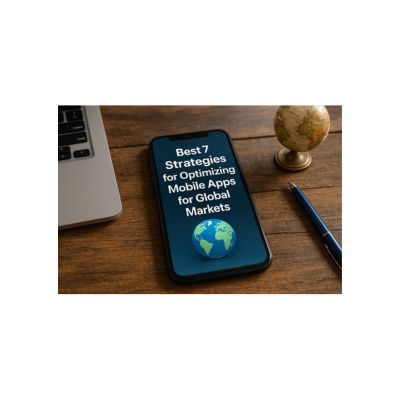In today’s interconnected world, the ambition for any mobile application often extends beyond local boundaries. To truly unlock growth potential, app developers and businesses must strategically optimize their mobile apps for global markets. This involves far more than simple translation; it’s a holistic approach that ensures the app resonates culturally, performs flawlessly, and complies with diverse regulations worldwide. For a Mobile App Development Company, mastering these strategies is key to building successful international products.
Here are the best 7 strategies for optimizing mobile apps for global markets:
1. Comprehensive Localization (Beyond Translation)
Localization is the cornerstone of global expansion. It means adapting your app to specific target markets, encompassing linguistic, cultural, and functional elements. Merely translating text is insufficient; true localization involves cultural nuances that make the app feel native to its users.
- Linguistic Adaptation: This goes beyond direct translation. It includes adapting idiomatic expressions, slang, humor, and even formal/informal tones to suit the local language and dialect. For example, “English” can vary significantly between different English-speaking regions.
- Content and Context: Review all in-app content, including text, images, videos, and audio. Are there any elements that might be culturally insensitive, confusing, or irrelevant? This includes ensuring character representation in images is diverse and appropriate for the target audience.
- Date, Time, and Number Formats: Adapt formats for dates (DD/MM/YYYY vs. MM/DD/YYYY), time (12-hour vs. 24-hour clock), currency symbols, decimal separators, units of measurement (metric vs. imperial), and phone number formats.
- Right-to-Left (RTL) Language Support: For languages like Arabic, Hebrew, and Urdu, the app’s entire layout and UI elements must be mirrored to support RTL reading direction. This is a significant design and technical consideration.
Impact: A deeply localized app feels familiar and trustworthy, significantly increasing user engagement, retention, and conversion rates by overcoming communication and cultural barriers. It conveys respect for the local culture.
2. Culturalization of UI/UX Design
Culturalization delves into the visual and interactive elements of the app, ensuring the User Interface (UI) and User Experience (UX) align with local cultural norms and expectations. This is critical for intuitive navigation and emotional connection.
- Color Symbolism: Colors carry different meanings across cultures. For example, red can symbolize passion or danger in some regions, while in others, it might signify good fortune or mourning. Researching local color connotations is essential to evoke the intended emotional response.
- Iconography and Symbols: Universal icons are rare. An icon that is clear in one region might be ambiguous or even offensive in another. Testing local understanding of icons and symbols (e.g., a “home” icon, checkmarks, arrows) is crucial.
- Visual Storytelling: Imagery used in the app should reflect the demographics, lifestyles, and values of the target audience. Stock photos featuring people or scenes from a different cultural context can alienate users.
- Navigation Patterns: While global standards exist, subtle preferences in navigation or information hierarchy can vary. Some cultures prefer more direct, linear flows, while others might be accustomed to more exploratory interfaces.
- Hofstede’s Cultural Dimensions: Concepts like “Power Distance” (acceptance of authority), “Individualism vs. Collectivism,” and “Uncertainty Avoidance” can influence how users expect information to be presented and how they interact with an app. For instance, collective cultures might appreciate community features more.
Impact: A culturally intuitive UI/UX reduces cognitive load, minimizes frustration, and builds a stronger emotional connection with users, making the app feel like it was designed specifically for them. A skilled Mobile App Development Company will include cultural experts in their design process.
3. Localizing App Store Optimization (ASO)
Even the most well-designed and localized app won’t succeed globally if users can’t find it. Localized App Store Optimization (ASO) is vital for improving visibility, discoverability, and conversion rates in regional app stores.
- Keyword Research: Conduct extensive keyword research for each target market in their native language. Direct translation of keywords often doesn’t capture local search intent or popular phrases. Utilize local search trends, competitor analysis, and specific ASO tools.
- Localized App Title and Subtitle/Short Description: Craft unique titles and subtitles/short descriptions for each locale, incorporating relevant localized keywords. This improves search rankings and relevance.
- Localized App Description: Translate and adapt the full app description to highlight features and benefits that resonate with the local audience, incorporating localized keywords naturally.
- Localized Screenshots and App Previews: Visuals are powerful. Use screenshots and video previews that showcase the app in the local language, with culturally relevant images and scenarios. For instance, if an app has a food delivery feature, show local dishes and typical delivery environments.
- Ratings and Reviews: Encourage and respond to user reviews in local languages. Positive local reviews significantly impact discoverability and conversion.
Impact: Effective localized ASO dramatically increases organic downloads and user acquisition by making the app visible and appealing to the right audience in each target market.
4. Implementing Diverse Local Payment Methods
Payment preferences vary wildly across the globe, and failing to support preferred local payment methods can be a significant barrier to monetization. A global app must offer a flexible and secure payment gateway.
- Credit/Debit Cards: While universally accepted, certain card networks might be more prevalent in specific regions.
- Digital Wallets: Embrace popular digital wallets specific to a region (e.g., Google Pay, Apple Pay are global, but others like UPI in one region, WeChat Pay/Alipay in another, or specific bank-backed wallets are crucial in their respective markets).
- Bank Transfers: In many regions, direct bank transfers or specific local bank payment systems are preferred over card payments.
- Cash on Delivery (COD): In some emerging markets, COD remains a popular and trusted payment method for e-commerce or delivery apps.
- Buy Now, Pay Later (BNPL): The rise of BNPL services requires integration for many apps, especially in retail.
- Local Acquiring Banks: Partnering with local acquiring banks or payment service providers can reduce transaction costs, improve authorization rates, and comply with regional financial regulations.
- Currency Conversion: Display prices and allow transactions in local currencies, ensuring accurate and transparent conversion rates.
Impact: Supporting diverse local payment methods drastically improves conversion rates, customer trust, and overall revenue by removing friction from the purchase process. A forward-thinking Mobile App Development Company will prioritize flexible payment gateway integrations.
5. Ensuring Regulatory Compliance and Data Privacy
Navigating the complex and ever-evolving landscape of international regulations, particularly concerning data privacy, is non-negotiable for global app success. Non-compliance can lead to hefty fines, legal battles, and severe reputational damage.
- GDPR (General Data Protection Regulation): If your app collects or processes data from users in one specific economic bloc, compliance with GDPR is mandatory, regardless of your company’s physical location. This includes strict requirements for consent, data access, data erasure (“right to be forgotten”), and data breach notifications.
- CCPA (California Consumer Privacy Act) / CPRA (California Privacy Rights Act): If targeting users in certain regions, understand and comply with laws giving consumers significant control over their personal information, including rights to know, delete, and opt-out of selling their data.
- Sector-Specific Regulations: Industries like healthcare (e.g., HIPAA for Protected Health Information) or finance have additional, stringent data security and privacy requirements that vary by region.
- Accessibility Laws (e.g., ADA): Ensure the app is accessible to users with disabilities, often a legal requirement in many regions, by supporting features like screen readers, adjustable font sizes, and high-contrast modes.
- Intellectual Property Rights: Be aware of trademark, copyright, and patent laws in each target market to avoid infringement and protect your own intellectual property.
- Privacy by Design: Integrate privacy considerations into the app’s architecture and design from the very beginning, ensuring that data collection is minimized and encrypted.
Impact: Demonstrating robust data privacy and regulatory compliance builds immense user trust and brand credibility, while mitigating significant legal and financial risks associated with global operations.
6. Optimizing Performance for Varied Network Conditions & Devices
Global markets encompass a vast spectrum of internet connectivity speeds, data plan costs, and device specifications. An app optimized for high-speed broadband and flagship devices may struggle significantly in regions with limited bandwidth or older hardware.
- Network Optimization:
- Minimize Data Usage: Compress images and videos, use efficient data formats (e.g., WebP for images), and implement smart caching strategies to reduce reliance on constant network calls.
- Offline Capabilities: Design the app to function effectively even with intermittent or no internet connectivity. This is crucial for user retention in areas with unreliable networks.
- Lazy Loading: Load content and features only when they are needed, rather than all at once at startup.
- CDN (Content Delivery Network): Utilize CDNs to deliver app assets (images, videos, scripts) from servers geographically closer to the user, significantly reducing load times.
- Device Compatibility:
- Lightweight Code: Write clean, efficient code to ensure smooth performance on devices with lower processing power and memory.
- Responsive Design: Ensure the UI/UX adapts seamlessly to a wide range of screen sizes, resolutions, and aspect ratios found on diverse mobile devices.
- Thorough Testing: Conduct extensive testing on a variety of low-end, mid-range, and high-end devices, across different operating system versions and network conditions prevalent in target markets.
Impact: A performant app across various technical environments ensures a positive user experience for a broader global audience, reducing uninstalls due to lag, crashes, or excessive data consumption.
7. Providing Multilingual Customer Support & Community Engagement
Effective customer support and community building in local languages are crucial for long-term user satisfaction and retention in global markets. It shows that the company genuinely cares about its international users.
- Multilingual Support Channels: Offer customer support through channels popular in each region (e.g., in-app chat, email, local phone numbers, messaging apps like WhatsApp or Line), staffed by native speakers or utilizing advanced translation tools.
- Localized FAQs and Help Centers: Provide comprehensive self-help resources, FAQs, and troubleshooting guides translated and culturally adapted for each market.
- Community Forums and Social Media: Create and moderate in-app community forums or leverage local social media platforms where users can connect, ask questions, and get support in their native language.
- Local Influencer Marketing: Collaborate with local influencers to promote the app, engage with the audience, and build credibility within specific communities.
- Feedback Mechanisms: Provide easy ways for users to submit feedback and bug reports in their native language, and ensure these are promptly addressed.
Impact: Accessible and culturally sensitive customer support builds strong user trust and loyalty, turning users into advocates. Active community engagement fosters a sense of belonging, driving organic growth and retention in new markets.
Conclusion
Expanding a mobile app into global markets is a strategic imperative for sustained growth. It requires a nuanced understanding of diverse user needs, technological landscapes, and regulatory frameworks. By prioritizing comprehensive localization, culturally sensitive design, localized ASO, diverse payment options, robust compliance, performance optimization, and dedicated local support, a Mobile App Development Company can effectively overcome the complexities of international expansion. These strategies, when meticulously implemented, pave the way for mobile applications to achieve widespread adoption and lasting success on a global scale.



